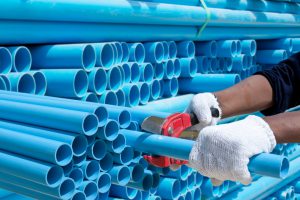Old Piping Materials in Your Home May Need to Be Replaced
 How much do you know about your home’s plumbing in Santa Fe, NM? Not much, we imagine. Plumbing isn’t a glamorous part of any house; it needs to function without drawing attention to itself.
How much do you know about your home’s plumbing in Santa Fe, NM? Not much, we imagine. Plumbing isn’t a glamorous part of any house; it needs to function without drawing attention to itself.
Understanding the age of your home’s plumbing pipes is important, however, because piping material is not invulnerable. All material wears down, and pipes are no exception. Making the situation more difficult is that the material used for pipes has changed over the decades. Outdated materials—we’ll get to those in a moment—have a higher chance of decay, bursting, and corrosion. If your house contains these old pipes, you may need to have partial or whole-house repiping done. Licensed professional plumbers are the only people you can trust with this service.
Outdated Pipe Material
Several materials used in household plumbing are no longer used for new construction or replacements, and for good reasons. Below are the ones you’re most likely to find in your house if it was built before 1990.
- Cast iron: The oldest type of material you’ll find in a house in the area. Cast iron was common up until around the 1960s. If it’s still in your house, it needs to be replaced, since the chance of it already corroding and putting toxins into your water (such as lead) is high.
- Galvanized steel: As iron was phased out, galvanized steel became the top piping material. This steel was dipped in a zinc solution to help it avoid corrosion. The zinc solution can become its own problem, however, and it won’t stop corrosion forever. After fifty years, steel pipes will begin to corrode and rust, making them prime candidates for repiping.
- Polybutylene: In the 1970s, copper and plastic pipes became the main piping materials. Copper is still used, but not all types of plastic ended up enduring. A common type of plastic pipe used through the 1980s was polybutylene, which was an inexpensive pipe material useful for freshwater lines. Until it wasn’t. Polybutylene tends to crack with exposure to heat, and in the 1990s its use was halted. It’s an easy type of plastic to identify: it’s a drab gray color. We strongly recommend having polybutylene pipes replaced.
The New Pipe Materials
What kind of pipe material will work for your home today? Plumbers have different options, and an important part of the repiping job is the choices a professional plumber makes for new material.
The three common materials used today are copper, CPVC plastic, and PEX plastic. Copper is great for freshwater and sewer lines, as well as trunk lines in the house. Copper is lightweight, inexpensive, corrosion resistant, and less susceptible to snapping. CPVC (chlorinated polyvinyl chloride) has surpassed PVC as the top plastic pipe. PEX (cross linked polyethylene) is also used in certain applications.
If you have questions about what kind of pipes are in your home and if you need some amount of repiping, call our plumbing pros and request an estimate.
Why wait for services when you can get it EXPRESS? Santa Fe Express Plumbing & Drain serves Santa Fe, Espanola, Los Alamos, and Pecos.

